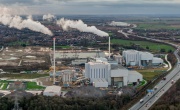Defossilisation versus decarbonisation
Defossilisation versus decarbonisation. What’s in a word? When it comes to climate change, a lot. Three gigatons of greenhouse gas emissions a year, to be precise. All coming from the global chemicals industry. Dr Jen Vanderhoven, COO of the BBIA, explores.
 The summer of 2023 has seen unprecedented heatwaves and wildfires across Europe and the US, as well as the hottest day ever recorded globally in July, with temperatures that would not have been possible without human-induced climate change.
The summer of 2023 has seen unprecedented heatwaves and wildfires across Europe and the US, as well as the hottest day ever recorded globally in July, with temperatures that would not have been possible without human-induced climate change.
We’re living in a world of mass consumption, with technology evolving at an increasingly fast rate. We’re seeing things becoming instantly available and delivered directly to our doors, at the touch of a button. Here in the UK, we seem unaware of the impact of our overconsuming, materialistic lifestyles. but current consumption levels, and those in other affluent nations are unsustainable and account for a disproportionate amount of the overall negative environmental impact caused by human activity
Decarbonisation versus defossilisation
We hear the words ‘sustainability’ and ‘net zero’ everywhere, and politicians talk about how we need to ‘decarbonise’ industry, because it releases huge amounts of CO2, ultimately leading to global warming. But what does all this actually mean?
Carbon is a fundamental element that is an essential building block of life on Earth, and it plays a crucial role in various natural processes. While carbon atoms themselves are not in short supply, the problem lies in the imbalance between the release of carbon into the atmosphere and the Earth's ability to naturally sequester or absorb that carbon through processes like photosynthesis in plants, carbon storage in forests and oceans, and mineralization in rocks over long periods.
We know we need to reduce the amount of fossil resources we are using, and we have committed as a nation to become net zero by 2050. Net zero means that a country takes as much CO2 out of the atmosphere as it puts in. Considering in 2021, in the UK alone, we emitted 299 million tonnes of CO2 (70 per cent of all greenhouse gases). This is a huge task.
So, what can we do? The UK government is focusing on decarbonisation, which is the process of reducing the carbon content of something, and in the context of climate change, it primarily focuses on reducing CO2 emissions. Some things can be almost completely decarbonised, such as energy, via, for example, renewable wind and solar power. Other things cannot be decarbonised since they are made of carbon. This is where defossilisation comes into play, reducing our dependence on fossil resources and instead using sources of renewable carbon Defossilisation, however, is not something that is currently being talked about in the UK.
Plastic fantastic
Plastic is amazing. It has allowed us to land on the moon, place stents in people’s hearts, and dive deep in the ocean discovering new creatures. However, over the last decades, as humans, we have misused plastic technology. As of 2021, globally, more than 10 billion tonnes of plastic waste were generated – with only 9 per cent recycled, -12 per cent incinerated, and 79 per cent accumulated in landfills or the open environment. The largest market for plastics today is packaging which accounts for nearly half of all plastic waste globally and more than 40 per cent of plastic is used just once, then discarded.
Plastics are made from chemicals, which contain carbon. This carbon usually comes from fossil resources, and this means that these materials account for 10 per cent of CO2 emitted globally annually and a whopping three gigatonnes of GHG emissions. With these emissions being almost entirely Scope 3, being generated in the extraction and conversion of fossil resources, the only currently feasible way to reduce these is to change the source material. Since feedstock needs to be carbon-based, this means plastic cannot be decarbonised, but instead needs to be defossilised. The key challenge with defossilisation of the chemical and plastics industry is, therefore, the requirement for carbon-based feedstocks, but from renewable sources.
The bioeconomy and bridging the gap
We know that when people buy less stuff, emissions, resource consumption and pollution drop. But with consumer habits changing too slowly to counteract climate change, what can we do? How can we become more sustainable? For a step change to happen, and for climate change to be slowed, we need a major change in the way we find and use resources. But this time, we need a bio-based revolution that works with nature, not against it.
We also know that to drive the whole chemicals and plastics sector to become more sustainable relies on the ability to convert readily available and renewable carbon feedstocks into products. This is where the bioeconomy comes into play. This is an economic system in which biological resources, such as plants, animals, and microorganisms – and their byproducts – are used to produce a wide range of products, including chemicals; where waste from one process becomes a resource for another. However, the transition from petrochemical to biochemical feedstocks remains extremely challenging, particularly concerning the conversion of widely available, non-food biomass (such as forestry, aquaculture, and agricultural residues) into valuable chemical building blocks.
The wrong priorities
Innovation in this area is slow and hampered by a lack of Government regulatory and investment support to incentivise bio-based materials production and commercialisation. The recent UK Biomass strategy highlights the Government’s lack of understanding of the contribution that biobased and biodegradable materials can make to climate change. The Biomass Strategy also demonstrates that there is a clear lack of understanding within the UK Government as to the difference between decarbonisation and defossilisation.
The strategy talks about how biomass “should be prioritised for the hardest-to-decarbonise sectors first”, yet then focuses on the bioenergy sector, which can in fact be drastically decarbonised.
Instead, the strategy focuses on the use of biomass on unproven Bioenergy Carbon Capture and Storage (BECCS) technology.Many experts urge caution in relying too heavily on BECCS in policy, as deferring emissions reductions to a technology unproven at scale can encourage complacency, and this deferral can become a form of greenwashing. On top of this, Emissions Trading Schemes risk driving manufacturing out of Europe, and BECCS can leave no greenhouse gases to be accounted for, encouraging ongoing use of fossil feedstocks. Meanwhile, nature has already provided us with the solution. Evolved over millions of years, photosynthesis is nature’s original and effective carbon capture and storage, taking CO2 from the atmosphere and fixing it into carbon in biomass.
Getting left behind
The UK is the home of significant and long-standing academic excellence in bio-based materials and chemicals, giving us the potential to be a leader in this field, but other areas of the world are already implementing policies to drive this sector forward and the UK is rapidly losing this competitive advantage.
As stated in the Biomass Strategy, the Government feels that much more work is needed to understand the role of biomass in the materials and chemicals manufacturing sectors. There is currently no national policy on sustainable materials and little clarity on the future of bio-based chemicals, and government needs to act so that the UK can achieve a net-zero-compatible materials economy with the bioeconomy at the heart of this.
There needs to be more understanding of what is happening globally, especially the strides forward being made in USA. Under the Inflation Reduction Act in the USA, the administration has established new targets for the American bioeconomy, through its new ‘Bold Goals for US Biotechnology and Biomanufacturing’ strategy, with ambitious goals for their chemicals and materials sector. Engineering biology and biomanufacturing are core to all this work. Achieving these goals will position the US at the forefront of a vibrant global bioeconomy while producing net-zero or net-negative emissions, reducing the use of and reliance on fossil fuels, and increasing the use of recyclable-by-design chemicals and materials. Alongside this, they have set ambitious targets, including that in five years’ time, the chemicals and materials sector will have reduced its lifecycle CO2 emissions by 70 per cent, and in 20 years’ time, 90 per cent of all plastics will be bio-based.
Whilst the US’s aspirational targets may not be achievable, the administration has put financial resources behind the policy to stimulate the production of bio-based plastics. The UK has no such Bioeconomy Strategy having withdrawn the 2018 version in 2021 thus leaving the field to American competition and other countries who are adopting similar approaches.
Urgent action required
The UK urgently needs a new and meaningful bioeconomy strategy, with a significant associated funding package, that has at its heart the stimulus of bio-based industrial development, through market targets and mandates for bio-based materials in the UK marketplace. Incentives to transition to bio-based plastics could include tax credits, grants, and subsidies for research and development, production, and use of bio-based chemicals. For example, key stakeholders have called out the ‘plastics tax’, a policy offering tax incentives if products contain more than 30 per cent recycled plastic by content. It is strongly felt that this should be rolled out to all biomass-derived, biodegradable, and compostable products.
Consistent long-term funding for research and development into bio-based chemicals and materials, including funding for academic institutions, research organizations and private companies is also required, to accelerate technological advancements, scale up production, and reduce costs, making bio-based chemicals more competitive with their conventional counterparts. Alongside this, there is a need to simplify REACH registration (a regulation that applies to the majority of chemical substances that are manufactured in or imported into the UK) for chemicals made from biobased feedstocks and to subsidise the cost. Biobased chemicals often face cost challenges when compared to their fossil-based counterparts. High capital investment costs, limited economies of scale, and the dependency on fluctuating feedstock prices can make biobased chemical production economically unviable. Achieving cost parity or cost advantage is crucial for their commercialization and widespread adoption.
Championing the bioeconomy
 Here at the Bio-based and Biodegradable Industries Association (BBIA), we recognise the importance of the bioeconomy in reducing our reliance on fossil resources. The use of biobased materials is a key solution that can help mitigate the temperature rises that we are experiencing.
Here at the Bio-based and Biodegradable Industries Association (BBIA), we recognise the importance of the bioeconomy in reducing our reliance on fossil resources. The use of biobased materials is a key solution that can help mitigate the temperature rises that we are experiencing.
The great hope of the bioeconomy is that it offers a realistic opportunity to make a major contribution to creating a sustainable circular economy, where waste is closer to zero. It is imperative that the UK leads in developing the possibilities that the bioeconomy offers, not just for the future well-being of the UK population, but for the future of the planet. Of course, this will not happen spontaneously. We need supportive long-term government policies, investments to nurture academic-industrial partnerships and rapid commercialisation, enhanced access to pilot facilities for SMEs, and simplified but rigorous regulatory frameworks, to make the UK a world leader.
We cannot afford to be left behind. We must urgently focus on the defossilisation of those hard-to-decarbonise sectors. Key to this is raising awareness of the difference between defossilisation and decarbonisation, since when it comes to climate change this means a lot.
For more information, please get in touch with Jen Vanderhoven, COO, BBIA [email protected]




